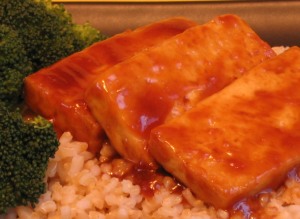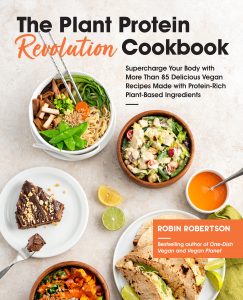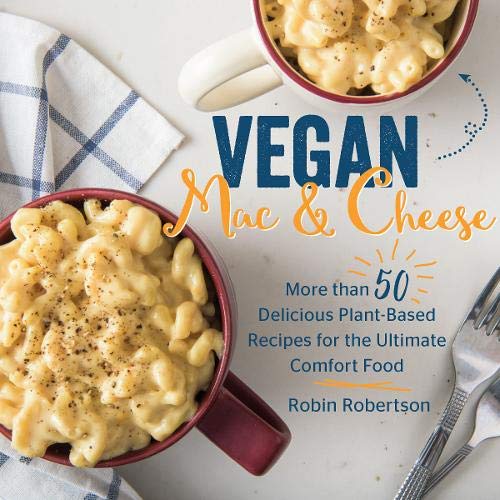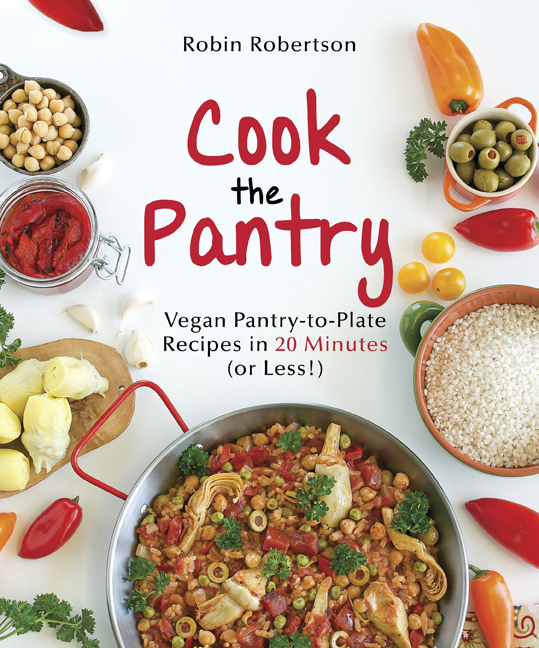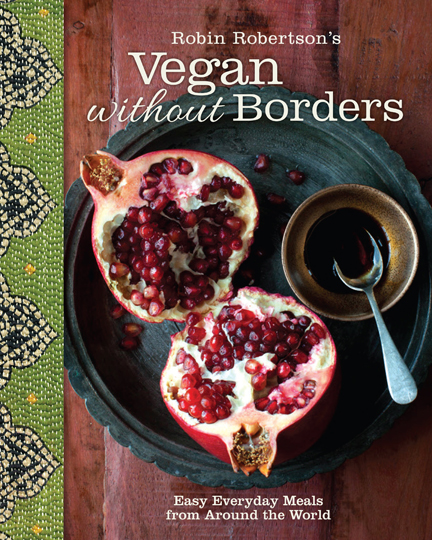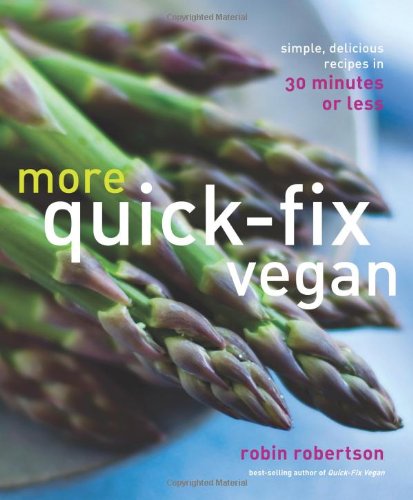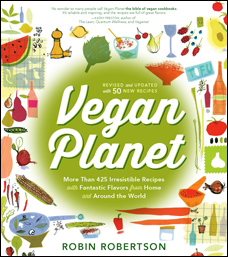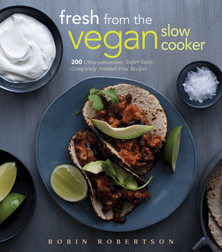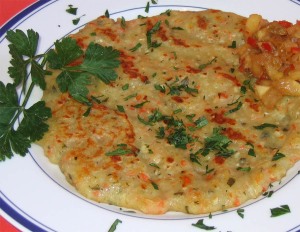
When I lived in Virginia Beach, we used to frequent a wonderful Indian restaurant that featured Southern Indian cooking. The menu was filled with a wide variety of idlis, dosas, and uttappams paired with a luscious vegetable sambar and a sublime coconut chutney. The menu also had a number of fragrant vegetable dishes including an addictively delicious fiery hot cauliflower appetizer that I still dream about. Although it was not a vegan restaurant, Peter, the owner, was vegan, so he was happy to prepare a vegan version of virtually everything on the menu. His kindness didn’t end there, for when I asked him to share some of his delicious recipes with me, he generously obliged, and I’ve included my variations of a few of his recipes in 1000 Vegan Recipes.
One of my favorites is uttappam, a savory Southern Indian pancake that was described on Peter’s menu as “Indian pizza.” As a nod to Peter’s playful menu description, I call my recipe Indian-style Pizza, although there’s really no similarity between them, except to say that both pizza and uttappam are round and delicious.
I developed the recipe from my scribbled notes, and, although it may not be 100% authentic, it’s a very close representation of the original, and it tastes great. It’s made with semolina flour, called sooji, available in Indian markets and gourmet grocers. But if you can’t find sooji, you can use half regular all-purpose flour and half chickpea flour, which will still taste good, but with a slightly different texture. And, of course, you can spice it up with more hot chile or ground coriander, if you like. I prefer a more moderately spiced uttappam, since I like to liberally douse it with a spicy vegetable sambar (or dal) and coconut chutney. For my most recent uttappam craving, however, I served it with a dollop of Pear and Apple Chutney (from 1000 Vegan Recipes), since that’s what I had on hand. (In the photo, the colors almost blend in — the chutney is in the upper right corner and it was delicious.) Now if only I had some of that spicy cauliflower….
BOOK GIVEAWAY ALERT: Alisa, over at One Frugal Foodie, is giving a way a copy of 1000 Vegan Recipes — hurry over there (after you’re done reading this post, of course!) for your chance to win. The contest closes midnight tonight.
Here’s the recipe for my Indian-Style Pizza from 1000 Vegan Recipes, followed by the recipe for Anshu’s Red Lentil Sambar, from Vegan Fire and Spice.
Indian-Style Pizza
This recipe makes two “personal pan”-size uttappam, enough for a main-dish for two or appetizers for four or more. Recipe is from 1000 Vegan Recipes by Robin Robertson © Wiley & Sons.
1 cup vegan plain yogurt
1 cup semolina flour (sooji)
1 tablespoon cornstarch
1/3 cup plus 2 tablespoons water
1 medium carrot, grated
1 hot or mild green chile, seeded and finely minced
1/3 cup minced onion
1/4 cup plus 1 tablespoon chopped fresh cilantro
1/4 cup finely chopped unsalted cashews
3/4 teaspoon ground coriander
1/2 teaspoon salt
2 tablespoons canola oil
1. Place the yogurt in a medium bowl and warm it in the microwave for 30 seconds. Stir in the flour and mix well to combine.
2. In a small bowl, combine the cornstarch with the 2 tablespoons of water. Blend well, then stir it into the flour mixture, adding the remaining 1/3 cup of water to form a thick batter.
3. Stir in the carrot, chile, onion, the 1/4 cup of cilantro, cashews, coriander, and salt, blending well. Set aside for 20 minutes at room temperature. Preheat the oven to 250 degrees F.
4. In a large skillet, heat the oil over medium heat. Pour half of the batter into the skillet. Cover and cook until the bottom is lightly browned and the batter is cooked through, about 5 minutes. Be careful not to burn.
5. Carefully slide the uttappam onto a baking sheet or heatproof platter and keep warm in the oven while you cook the second one with the remaining batter.
6. Invert each uttappam onto a dinner plate, sprinkle with the remaining 1 tablespoon cilantro, and serve.
Anshu’s Red Lentil Sambar
This recipe is from Vegan Fire & Spice by Robin Robertson © Vegan Heritage Press. It’s based on a recipe shared with me by my friend Sangeeta’s aunt. Note: Sambar powder is available in Indian markets and online. Serve this flavorful sambar with uttappam or over freshly cooked basmati rice.
1 cup red lentils
3 1/2 cups water
1 tablespoon canola oil
1 teaspoon black mustard seeds
1 onion, finely chopped
4 garlic cloves, minced
2 hot green chiles, seeded and minced
1 teaspoon grated ginger
1 (14.5-ounce) can diced tomatoes, drained
2 teaspoons sambar powder
1/2 teaspoon ground coriander
1/4 teaspoon cayenne
1/4 teaspoon ground cumin
1 teaspoon salt
1/2 teaspoon curry powder
1 cup finely chopped carrots
1 cup finely chopped cauliflower
1 cup green beans, cut into 1/2-inch pieces
1 cup finely chopped eggplant
1 tablespoon fresh lemon juice
1/4 cup chopped cilantro
Combine the lentils and water in a pot and bring to a boil. Reduce the heat to medium, cover, and simmer until soft, 30 minutes. Set aside, do not drain.
Heat the oil in a skillet over medium heat. Add the mustard seeds. When they begin to pop, add the onion, garlic, chiles, and ginger and cook until softened, 5 minutes. Stir in the tomatoes and cook 2 minutes. Stir in the sambar powder, coriander, cayenne, cumin, salt, and curry powder. Add the carrots, cauliflower, green beans, and eggplant. Cover and cook for 5 minutes to soften. Add the vegetable mixture to the reserved lentils, cover, and simmer until the vegetables are soft, 20 minutes. Add the lemon juice and cilantro and cook 5 minutes longer. (Note: For a “soupier” sambar, you can add more water or a little vegetable broth.)



